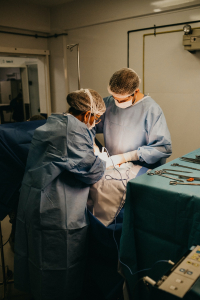Total hip replacement, also known as total hip arthroplasty, is a surgical procedure performed to alleviate pain and restore function in patients with hip joint disorders, such as osteoarthritis, rheumatoid arthritis, and hip fractures. This comprehensive guide will provide an in-depth look at total hip replacements, including the surgical procedure, potential risks, benefits, and the recovery process. With advancements in surgical techniques and implant materials, total hip replacements have become a reliable and life-changing solution for patients experiencing hip pain and limited mobility.
Understanding Hip Joint Anatomy & Disorders
The hip joint is a ball-and-socket joint, comprising the femoral head (the ball) and the acetabulum (the socket). The joint surfaces are lined with cartilage, allowing smooth and pain-free movement. Various factors, such as age, injury, or disease, can damage the hip joint and cause pain, stiffness, and reduced function.
Some common hip joint disorders that may necessitate a total hip replacement include:
- Osteoarthritis:
A degenerative joint disease characterised by the gradual wear and tear of cartilage, leading to bone-on-bone contact, inflammation, and pain. - Rheumatoid arthritis:
An autoimmune disease causing chronic inflammation of the joint lining (synovium), which can result in cartilage and bone destruction. - Hip fractures:
Severe fractures in the hip joint may require a total hip replacement, particularly in elderly patients with compromised bone quality. - Avascular necrosis:
A condition in which blood supply to the femoral head is disrupted, leading to bone death and joint collapse. - Developmental dysplasia:
A congenital disorder resulting in an abnormally shallow hip socket, which can cause hip joint instability and premature wear.
Total Hip Replacement Procedure
The primary goal of a total hip replacement is to replace the damaged joint surfaces with artificial components, known as prostheses. The procedure involves the following steps:
- Anesthesia:
Patients receive either general anesthesia or regional anesthesia (spinal or epidural) to ensure comfort during the surgery. - Incision:
The surgeon makes an incision over the hip to access the joint. The incision’s size and location can vary based on the surgical approach, such as posterior, anterior, or lateral.
- Removal of damaged bone and cartilage:
The surgeon removes the damaged femoral head and cleans the acetabulum, removing any damaged cartilage and bone. - Implantation of the acetabular component:
A metal or ceramic shell is implanted into the cleaned acetabulum, sometimes secured with screws. A liner made of plastic, ceramic, or metal is then inserted into the shell to create a smooth socket. - Implantation of the femoral component:
The surgeon prepares the femur by removing a portion of the bone and shaping the remaining bone to accommodate the femoral implant. The implant, usually made of metal or ceramic, is inserted into the prepared femur. A metal or ceramic ball is then attached to the implant, replacing the removed femoral head. - Joint stability testing:
The surgeon tests the new joint’s stability and range of motion, making any necessary adjustments to ensure proper function. - Closing the incision:
Once satisfied with the joint’s stability and function, the surgeon closes the incision with sutures or staples and applies a sterile dressing.
Risks & Complications
As with any surgery, total hip replacements carry some risks, although the overall complication rate is relatively low. Some potential risks include:
- Infection:
Prophylactic antibiotics are typically administered before and after surgery to minimise infection risk. In rare cases, deep infections may require further surgery or even removal of the implant. - Dislocation:
The newly implanted hip joint may become dislocated, particularly in the early postoperative period. In some cases, a brace may be required to stabilise the joint, or a surgical revision may be necessary. - Leg length discrepancy:
Although surgeons take precautions to maintain proper leg length, there may be slight differences in leg lengths postoperatively. This can often be addressed with orthotics (shoe inserts) or physiotherapy. - Implant loosening or wear:
Over time, the artificial joint components may wear or loosen, which may eventually require a revision surgery. - Nerve damage:
Rarely, nerves near the hip joint may be damaged during surgery, causing numbness, weakness, or pain. - Periprosthetic fracture:
Fractures around the implant may occur during or after surgery, potentially necessitating further intervention.
Recovery & Rehabilitation
The recovery process following a total hip replacement is crucial to achieving the best possible outcomes. Here are the key components of the recovery process:
- Hospital stay:
Patients typically remain in the hospital for one to four days following surgery, depending on individual circumstances and the surgical approach used. - Pain management:
Pain control is essential for patient comfort and early mobilisation. Pain medications, including opioids, NSAIDs, and acetaminophen, may be prescribed to manage postoperative pain. - Physiotherapy:
Early mobilisation and physiotherapy are crucial for restoring function and preventing complications. Physiotherapists will guide patients through a tailored exercise program designed to improve strength, flexibility, and range of motion. - Assistive devices:
Patients may initially require a walker or crutches for support and stability. Gradually, patients will transition to using a cane and eventually walking without assistance. - Home care:
Patients will receive instructions on wound care, medication management, and activity restrictions during their recovery period. It’s essential to follow these guidelines to ensure optimal healing and minimise complications. - Long-term outcomes:
Most patients experience significant pain relief and improved mobility following total hip replacement. With proper care and adherence to activity restrictions, modern hip implants can last 15-20 years or more.
Physiotherapy after Hip Replacement
Physiotherapy rehabilitation is a crucial component of the recovery process following a total hip replacement. It plays a significant role in helping patients regain mobility, restore function, and achieve the best possible outcomes. The importance of physiotherapy rehabilitation after total hip replacement can be highlighted through the following aspects:
- Early mobilisation:
Physiotherapists encourage patients to begin moving and walking shortly after surgery, which helps prevent complications such as blood clots, joint stiffness, and muscle weakness. Early mobilisation also promotes blood circulation and healing. - Range of motion and flexibility:

Physiotherapy exercises are designed to gradually increase the range of motion in the new hip joint and improve flexibility. This is essential for regaining normal movement patterns and preventing joint stiffness or scar tissue formation. - Muscle strength and stability:
Following surgery, muscle weakness around the hip joint is common due to disuse or muscle imbalances. Physiotherapists guide patients through targeted strengthening exercises to restore muscle strength, improve joint stability, and reduce the risk of dislocation or other complications. - Gait re-education:
Total hip replacement may temporarily alter a patient’s gait or walking pattern. Physiotherapists work with patients to re-educate their gait, focusing on proper weight-bearing, alignment, and balance. This helps ensure a smooth and safe transition from using assistive devices like walkers or crutches to walking independently. - Pain management:
Physiotherapy interventions, such as manual therapy, therapeutic exercises, and modalities like heat or ice, can help manage postoperative pain and swelling. This can reduce the need for pain medications and promote a more comfortable recovery process. - Education and self-management:
Physiotherapists provide patients with education on postoperative precautions, activity modifications, and safe movement patterns. They also teach patients how to perform specific exercises independently at home, fostering an active role in their recovery and long-term joint health. - Improved functional outcomes:
Adherence to a physiotherapy rehabilitation program has been shown to lead to better functional outcomes and higher patient satisfaction following total hip replacement. Patients who engage in regular physiotherapy tend to experience faster recovery times, better pain management, and greater overall improvements in mobility and quality of life. - Long-term joint health:
Physiotherapy rehabilitation helps patients develop healthy movement patterns and muscle balance around the hip joint, which can contribute to the long-term success of the implant and reduce the risk of future complications.
The Final Word on Hip Replacements
Total hip replacement is a highly effective surgical procedure that has transformed the lives of millions of patients suffering from hip joint disorders. By replacing the damaged joint with artificial components, patients can achieve significant pain relief and regain their mobility, improving their overall quality of life. It’s important to be aware of the potential risks and complications and to adhere to the recommended rehabilitation and recovery guidelines to ensure the best possible outcomes. With advancements in surgical techniques and implant materials, total hip replacements continue to provide a reliable and life-changing solution for those affected by debilitating hip pain and limited mobility.



